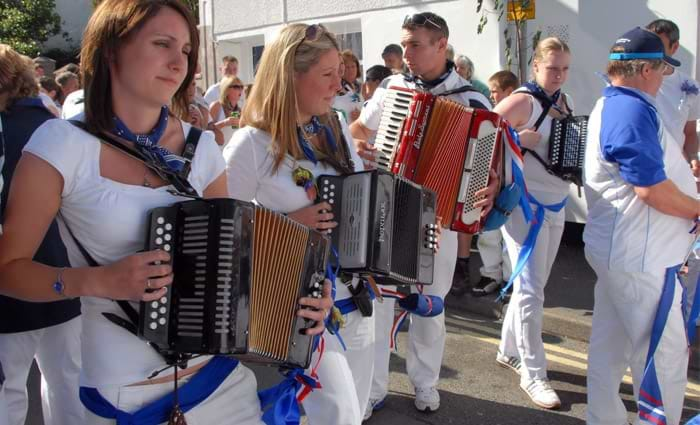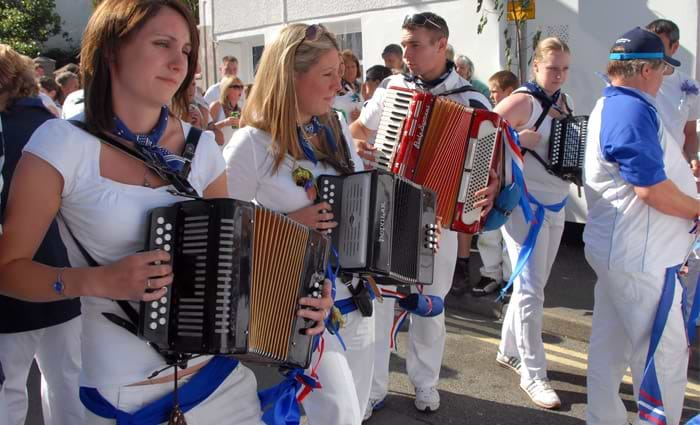
One of the UK's oldest surviving festivals, Obby Oss Day, welcomes the approach of summer. The event takes place annually on May Day in the coastal town of Padstow, Cornwall, in the south-west of England.
Believed to have its origins in Pagan fertility rights and the Celtic feast of Beltane, Obby Oss Day is famous for both its age and unique activities. It has become a massive visitor attraction, with people flocking in their droves to witness the amazing spectacle of life-size hobby horses being led through the streets.

What happens on Obby Oss Day?
Preparations in Padstow are extravagant, as the town's streets and historic harbour are decorated in a spectacular fashion with flags, flowers and greenery. A colourful and tall May Pole is erected as the centrepiece of the celebrations.
The fun begins at midnight on 30th April, when residents observe a local tradition by singing to the landlord of the Golden Lion Inn. The singing continues as the group moves around the town until the early hours of the morning.
The next day, local people collect flowers early in the morning to display around the town, while tree branches and foliage adorn lamp posts and drainpipes. At around 8am, children arrive in the town centre to parade their own hobby horses in readiness for the main event.
A band of drummers and accordion players accompanies the activities by playing the May Song. Spectators are encouraged to join in and sing along.
How many Obby Osses are there?
The May Day marchers wind their way through the town's narrow streets, leading two Obby Osses, the colloquial pronunciation of "hobby horses". These are stylish, life-size recreations of horses, wearing stunning masks. They are not real horses, but rather male dancers dressed up creatively.
Costumes consist of an oval frame covered in black oilskin, with a horse's head on the front with a mouth that opens and closes. The horses are led by a character known as The Teaser, who dresses all in white and carries a colourful, painted club.
The two horses are the Old Oss and the Blue Ribbon Oss. They are brought out of "stables" and returned there after the day's festivities. Setting off from different starting points, the Blue Ribbon Oss traditionally leaves its Padstow Institute stable at 10am, while the Old Oss sets off from the Golden Lion Inn an hour later.
At noon, the Old Oss arrives at Prideaux Place and dances for the crowd, before heading back to the Golden Lion. Later on in the day, the Blue Ribbon Oss also visits Prideaux Place to entertain the crowd.
The horses are followed by people dressed in all-white May Day garb, adorned with blue and red sashes, while children follow on their junior horses. Only local people whose families have lived in Padstow for a minimum of two generations can take part in the parade.
The two main horses try to "catch maidens" who are walking by in a type of unusual folk dance. The Obby Oss costumes change hands during the day, so each member of the group plays their part. Continuing all day, celebrations include the tradition of dancing around the May Pole and further parades at 2pm and 6pm.
At midnight, the local people join together to sing Padstow's May Song. The lyrics celebrate the approach of summer, with the revellers singing, "Unite, unite and let us all unite, for summer is a come unto day, and wither we will all unite in the merry morning of May."
The two Obby Osses finally meet at the May Pole on Broad Street and then return to their respective stables, with the promise they will be resurrected again the following year.
Why is Obby Oss Day celebrated?
The precise origins of the festival are unknown, but they are believed to be linked to Beltane, the Gaelic May Day festival held on 1st May. Beltane marked the beginning of summer when the cattle went out to the summer pastures.
Rituals were performed to protect the cattle and crops and to encourage growth. Bonfires were lit and the flames, smoke and ashes were believed to have protective power. Obby Oss Day has the same significance, in that it is a festival to herald and celebrate summer.
Author Charles Sandoe Gilbert, who wrote An Historical Survey of the County of Cornwall in the early 19th century, wrote of an Obby Oss festival that took place almost 200 years ago, in 1820. Describing it as an "annual jubilee", he said a man dressed in a "horse's skin" walked through the streets, amusing the crowd with "many whimsical exploits". These included what sounded like slapstick, as the Obby Oss threw water at the "gaping" mouths of his companions, causing them to swallow it.
Gilbert wrote of the spectators' "shouts of laughter", with the "merriments" accompanied by songs written especially for the occasion. Although the tradition appears to have changed little over hundreds of years, the practice of firing guns in celebration was stopped in the 1830s - local residents rallied together in 1837 to protest about the loud bangs and a clause was added to the Highway Act, forbidding the firing of guns within 50 feet of a carriageway or cart track.
In 1919, one major addition to the festival was the second horse, the Blue Ribbon Oss. Also known as the Temperance Oss, it was introduced to discourage drunkenness. Temperance campaigners objected to the heavy drinking associated with the festival. Although the bid to stop drinking didn't work, the tradition of having a second horse has continued.
This year's Obby Oss Day will take place on 1st May, with the Blue Ribbon Oss leaving its stable, as usual, at 10am, to mark the start of the procession.
Griggs Equestrian store stocks a range of high-quality equestrian equipment and clothing, including riding boots, chaps, helmets, body protectors, hats and more. Browse our website, or for a more personal service, pop in and see us.





